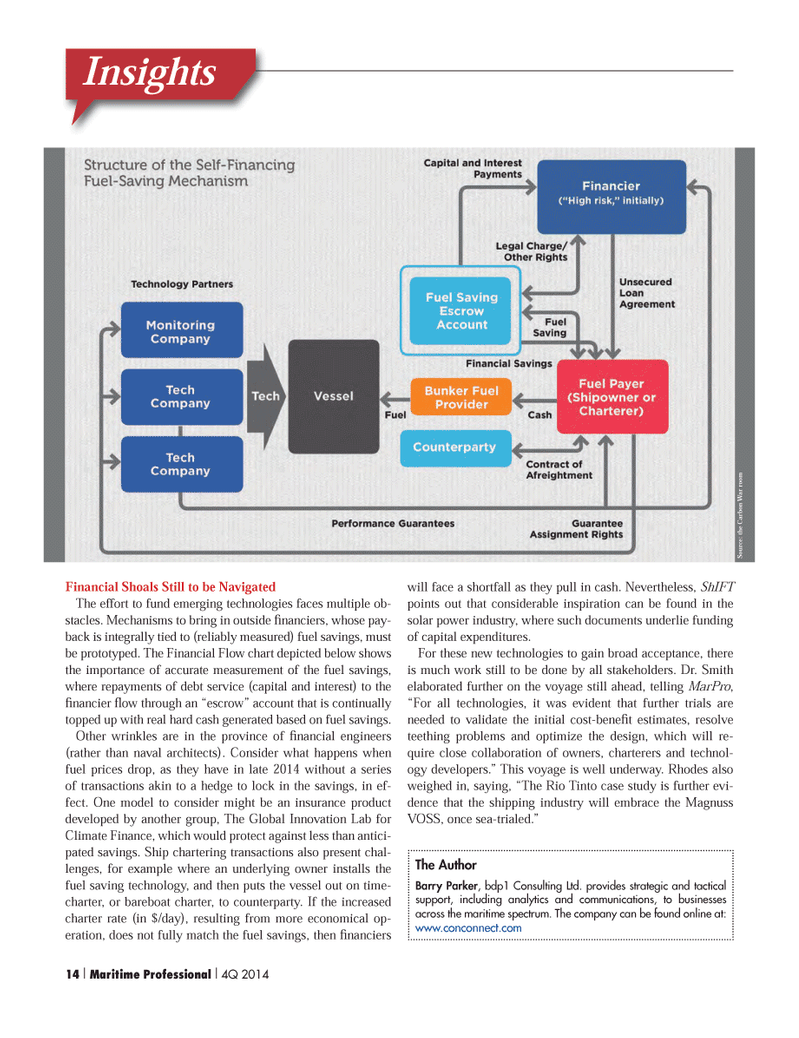
Page 14: of Maritime Logistics Professional Magazine (Q4 2014)
Read this page in Pdf, Flash or Html5 edition of Q4 2014 Maritime Logistics Professional Magazine
Financial Shoals Still to be Navigated The effort to fund emerging technologies faces multiple ob- stacles. Mechanisms to bring in outside Þ nanciers, whose pay-back is integrally tied to (reliably measured) fuel savings, must be prototyped. The Financial Flow chart depicted below shows the importance of accurate measurement of the fuel savings, where repayments of debt service (capital and interest) to the Þ nancier ß ow through an ÒescrowÓ account that is continually topped up with real hard cash generated based on fuel savings. Other wrinkles are in the province of Þ nancial engineers (rather than naval architects). Consider what happens when fuel prices drop, as they have in late 2014 without a series of transactions akin to a hedge to lock in the savings, in ef- fect. One model to consider might be an insurance product developed by another group, The Global Innovation Lab for Climate Finance, which would protect against less than antici- pated savings. Ship chartering transactions also present chal- lenges, for example where an underlying owner installs the fuel saving technology, and then puts the vessel out on time- charter, or bareboat charter, to counterparty. If the increased charter rate (in $/day), resulting from more economical op-eration, does not fully match the fuel savings, then Þ nanciers will face a shortfall as they pull in cash. Nevertheless, ShIFT points out that considerable inspiration can be found in the solar power industry, where such documents underlie funding of capital expenditures. For these new technologies to gain broad acceptance, there is much work still to be done by all stakeholders. Dr. Smith elaborated further on the voyage still ahead, telling MarPro , ÒFor all technologies, it was evident that further trials are needed to validate the initial cost-beneÞ t estimates, resolve teething problems and optimize the design, which will re-quire close collaboration of owners, charterers and technol- ogy developers.Ó This voyage is well underway. Rhodes also weighed in, saying, ÒThe Rio Tinto case study is further evi- dence that the shipping industry will embrace the Magnuss VOSS, once sea-trialed.Ó InsightsThe Author Barry Parker , bdp1 Consulting Ltd. provides strategic and tactical support, including analytics and communications, to businesses across the maritime spectrum. The company can be found online at:www.conconnect.com Source: the Carbon War room 14 I Maritime Professional I 4Q 20141-17 Q4 MP2014.indd 141-17 Q4 MP2014.indd 1411/17/2014 2:49:42 PM11/17/2014 2:49:42 PM

 13
13

 15
15
